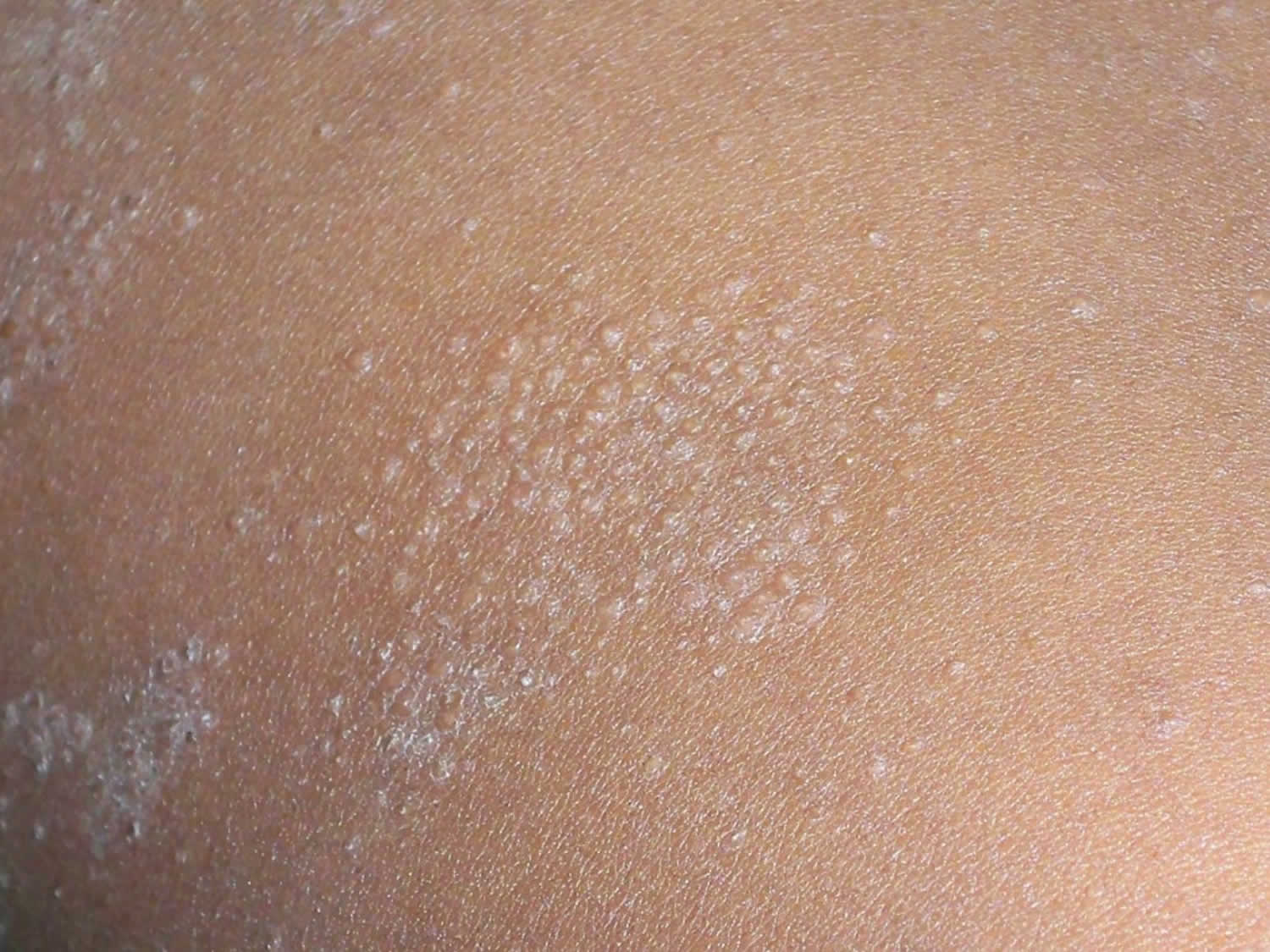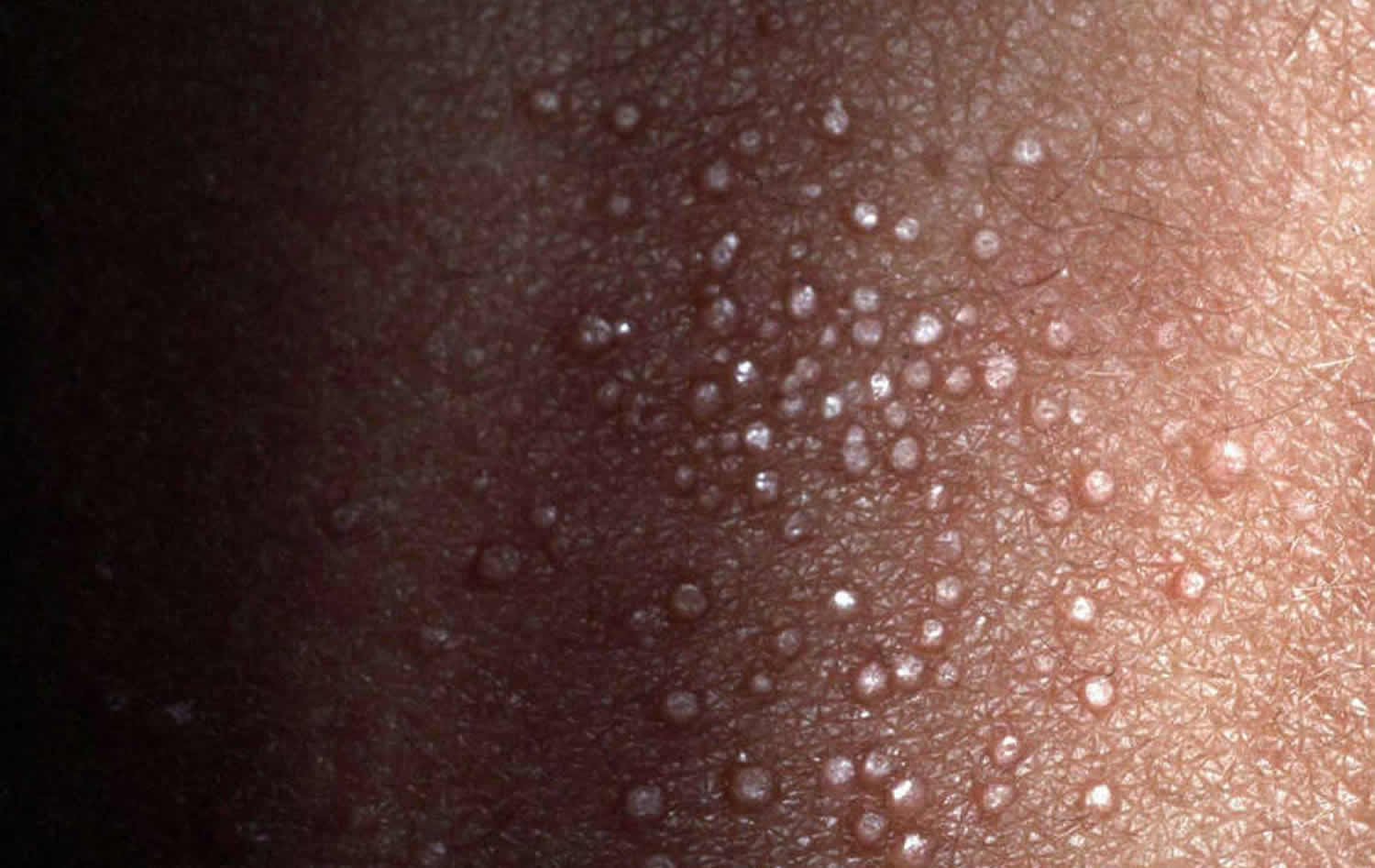What is lichen spinulosus?
Lichen spinulosus also called “keratosis spinulosa”, is a clinically distinctive variant of keratosis pilaris. Lichen spinulosus is characterized by solitary or multiple patches of minute follicular papules, each centered by a horny spine, which may occur on any part of the body. The classic lesion of lichen spinulosus is a keratotic plug located within the dilated follicular orifice 1. Histologically, an inflammatory lymphohistiocytic infiltrate occurs around the follicle and in the dermis. Hyperkeratosis, parakeratosis, and acanthosis are visible in the follicle. Differentiating lichen spinulosus from keratosis pilaris by microscopy may not be possible.
Reports indicate that lichen spinulosus is a disease that occurs during childhood to young adulthood. Peak incidence appears to occur during adolescence. Lichen spinulosus can persist for decades. In most patients, lichen spinulosus remits spontaneously within 1-2 years. Friedman calculated that in the Philippines, the average age at onset was 16.2 years ± 10.1 years 1.
In the past, lichen spinulosus was reported to be associated with the administration of arsphenamine, thallium, gold, and diphtheria toxin. More recently, authors have noted association with HIV disease 2 and Crohn disease 3. These associations may reflect the interests of the authors. Kabashima et al 4 reported lichen spinulosus in an alcoholic patient.
Figure 1. Lichen spinulosus
Lichen spinulosus causes
The cause of lichen spinulosus is unknown. Several possible causes have been postulated but none have been confirmed. These include:
- Reaction to an unidentified infection
- Association with atopy (inherited, familial tendency towards some form of allergy such as eczema, asthma or hay fever)
- Genetic predisposition
Lichen spinulosus signs and symptoms
Lichen spinulosus occurs during childhood to young adulthood, with most cases occurring during adolescence. Lichen spinulosus tends to have a sudden onset and is not accompanied by other signs and symptoms. The follicular papules are small rough bumps that appear in round or oval patches, which extend and spread rapidly over a few days to affect large areas of skin.
- Patches and plaques of follicular papules grow to between 2–5cm in diameter
- Patches develop symmetrically at intervals on the neck, buttocks, thighs, abdomen, knees and extensor surfaces of the arms
- Individual follicular papules are 1–3mm in diameter with a pointed or hair-like horny spine extending approximately 1mm around the tip of the follicle
When a patch is rubbed gently with the fingers, it has been likened to the feel of brushing your fingers over a nutmeg grater. The lesions do not cause any pain but some patients may complain of pruritus (itching).
Lichen spinulosus diagnosis
Lichen spinulosus diagnosis is made by clinical assessment alone. At present, no specific laboratory or diagnostic tests have been identified to make or confirm a diagnosis of lichen spinulosus. Histological findings of lichen spinulosus are similar to those found in keratosis pilaris.
Lichen spinulosus treatment
There is no specific treatment for lichen spinulosus and in most cases it resolves spontaneously within 1–2 years, although it can persist for decades in some patients. Some patients may find the following useful:
- Non-soap cleansers (soap may exacerbate the dryness)
- Moisturizing cream applied twice daily; try those containing urea, salicylic acid or alphahydroxy acids
- Rubbing with a pumice stone or an exfoliating sponge in the shower or bath
- Topical retinoids, which are gels or creams available on prescription. For the first few weeks of treatment, redness and peeling of the treated areas can be expected. Topical retinoids should not be used in pregnancy
- Laser assisted hair removal may also be of benefit in some cases
Lichen spinulosus prognosis
Lichen spinulosus can be ameliorated using emollient keratolytics. Case reports suggest that cure is the result of spontaneous remission over time. Most cases appear to remit within 1-2 years; however, well-documented cases exist that have lasted for decades.
Lichen spinulosus affects only the skin and is not known to be associated with abnormalities of internal organ systems. Occasionally, a patient with lichen spinulosus reports pruritus. Otherwise, the disorder mostly is of cosmetic significance. Misdiagnosis can result in inappropriate treatment.
- Lichen spinulosus. https://emedicine.medscape.com/article/1123533-overview[↩][↩]
- Cohen SJ, Dicken CH. Generalized lichen spinulosus in an HIV-positive man. J Am Acad Dermatol. 1991 Jul. 25(1 Pt 1):116-8.[↩]
- Kano Y, Orihara M, Yagita A, Shiohara T. Lichen spinulosus in a patient with Crohn’s disease. Int J Dermatol. 1995 Sep. 34(9):670-1.[↩]
- Kabashima R, Sugita K, Kabashima K, Nakamura M, Tokura Y. Lichen spinulosus in an alcoholic patient. Acta Derm Venereol. 2009. 89(3):311-2.[↩]






